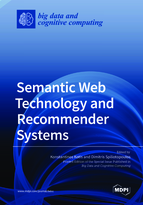Semantic Web Technology and Recommender Systems
A special issue of Big Data and Cognitive Computing (ISSN 2504-2289).
Deadline for manuscript submissions: closed (31 December 2022) | Viewed by 56870
Special Issue Editors
Interests: IoT; ontologies and semantic web
Special Issues, Collections and Topics in MDPI journals
Interests: recommender systems; usability; social media analysis; human–computer interaction
Special Issues, Collections and Topics in MDPI journals
Special Issue Information
Dear Colleagues,
Semantic web technologies define and analyse web data, linked or not, to enable semantic interconnection. This allows data analysts, application designers and cross-domain experts (linguists, cognitive scientists, machine learning experts, user interface designers) to utilise data semantics to build and work on approaches and ideas that require a deep understanding of the data at hand. Data-driven methods in computation and especially in recommender systems analyse single-source big data to identify and select recommendable content for users and applications. Multi-source data are a larger challenge. Such data are of immense value to understanding the user expectations and redefining the goals for content recommendation. The challenge is that combining data from distinct sources and for an undefined or unknown original target has to go through a layer of data understanding. Advanced data management and knowledge graphs are potential means of achieving the interlinking of data from original, social, cognitive and world sources.
This Special Issue will present the state-of-the-art in:
- semantic web methods and tools for advanced data analysis
- design and development of social data-driven applications
- intelligent analysis of complex data
- linguistic and psychological analysis of data
- human factors and the semantics of language communication
- methods for the enrichment of recommendation systems
- deep learning techniques for identifying and recommending content
- models, tools and methods that assist or supplement recommender systems
- privacy and security for semantic data management
- big data analytics for recommendation systems
- analytics and recommendation systems for semantic trajectories
- semantic sentiment analysis of big social data
- social and semantic web applications to politics
- social and semantic web applications to terrorism
- social and semantic web applications to psychology
- social and semantic web applications to societal issues
Dr. Konstantinos Kotis
Dr. Dimitris Spiliotopoulos
Guest Editors
Manuscript Submission Information
Manuscripts should be submitted online at www.mdpi.com by registering and logging in to this website. Once you are registered, click here to go to the submission form. Manuscripts can be submitted until the deadline. All submissions that pass pre-check are peer-reviewed. Accepted papers will be published continuously in the journal (as soon as accepted) and will be listed together on the special issue website. Research articles, review articles as well as short communications are invited. For planned papers, a title and short abstract (about 100 words) can be sent to the Editorial Office for announcement on this website.
Submitted manuscripts should not have been published previously, nor be under consideration for publication elsewhere (except conference proceedings papers). All manuscripts are thoroughly refereed through a single-blind peer-review process. A guide for authors and other relevant information for submission of manuscripts is available on the Instructions for Authors page. Big Data and Cognitive Computing is an international peer-reviewed open access monthly journal published by MDPI.
Please visit the Instructions for Authors page before submitting a manuscript. The Article Processing Charge (APC) for publication in this open access journal is 1800 CHF (Swiss Francs). Submitted papers should be well formatted and use good English. Authors may use MDPI's English editing service prior to publication or during author revisions.
Keywords
- semantic web
- semantics
- recommender system
- recommendation method
- big data analytics
- sentiment analysis
- social web







